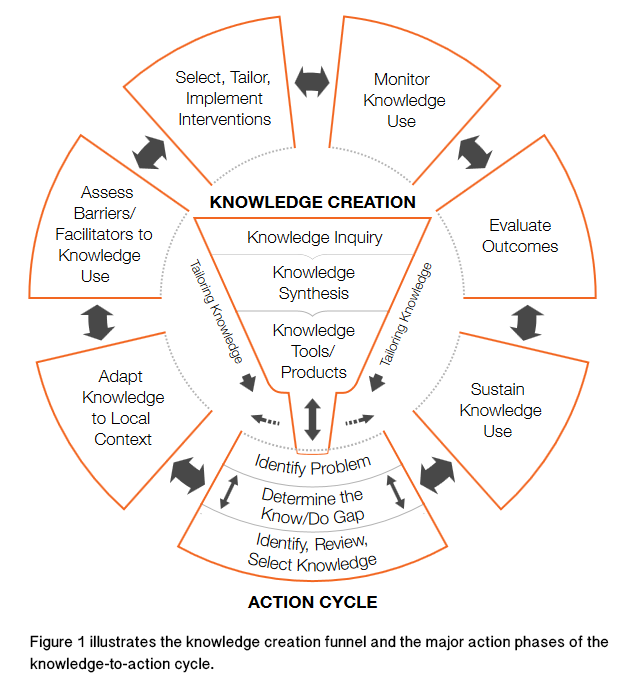Knowledge Translation
Our goal is to help disability researchers increase their understanding of knowledge translation (KT). This includes KT principles and processes. It also includes the methods related to them. KT methods help make research used and useful by making information easy to understand and apply in different situations.
What is Knowledge Translation, and why is it important?
KT is a process that makes sure our research and products can be used to improve the lives of people with disabilities.
KT is built on working with people who will use our resources. It makes sure that we ask the best research questions to get the right answers for the people who need them most.

Knowledge to Action Model
At KTDRR, we use the Knowledge to Action (KTA) model. This model helps us identify our stakeholders’ most pressing needs. In every step of the KTA model, we involve people who will use our research and products.
The KTA model lines up with KTDRR’s goals. These goals are to increase (a) the use of evidence-based research and (b) the understanding and use of KT principles.
Knowledge creation has three phases: (1) knowledge inquiry, (2) knowledge synthesis, and (3) knowledge tools and products.
The Action Cycle (Application) starts with an individual or group identifying the problem or issue, and the knowledge needed to solve it. Stakeholders adapt knowledge to local context; assess barriers and facilitators to knowledge use; select, tailor, and implement interventions; monitor knowledge use; evaluate outcomes; and sustain knowledge use.
Citation: Knowledge translation in health care (2nd ed.) by Straus, Tetroe, and Graham. John Wiley & Sons, 2013. https://ktbooks.ca/knowledge-translation-in-health-care/
KTDRR KT Tools, Resources, and Communities
- The KT Strategies Database brings together research evidence on KT tools and strategies.
- The KT Casebook was developed jointly with NIDILRR grantees. It highlights what grantees are doing in the area of KT.
- The KT Library includes links to information about KT and evidence-based resources. The library is for NIDILRR grantees and members of the public. The library includes information on the following topics:
- KTDRR’s Training Activities were created to help NIDILRR grantees increase their use of KT methods. Training includes a yearly online KT conference, workshops, and webcasts.
- The Plain Language Summary Tool (PLST) is an online tool that helps authors write plain language summaries of systematic reviews.
- To help NIDILRR grantees apply KT methods to their projects, the KTDRR offers free technical assistance (TA). To get TA, grantees can fill out a TA request form or e-mail ktdrr@air.org.
- The Expert Review Panel is made up of stakeholders. The panel makes sure that KTDRR’s products are accessible. It also makes sure that products meet the needs of people with disabilities. Finally, the panel makes sure that products are helpful for use in evidence-based decision making. To join the panel, e-mail ktdrr@air.org.
- Last Updated:
